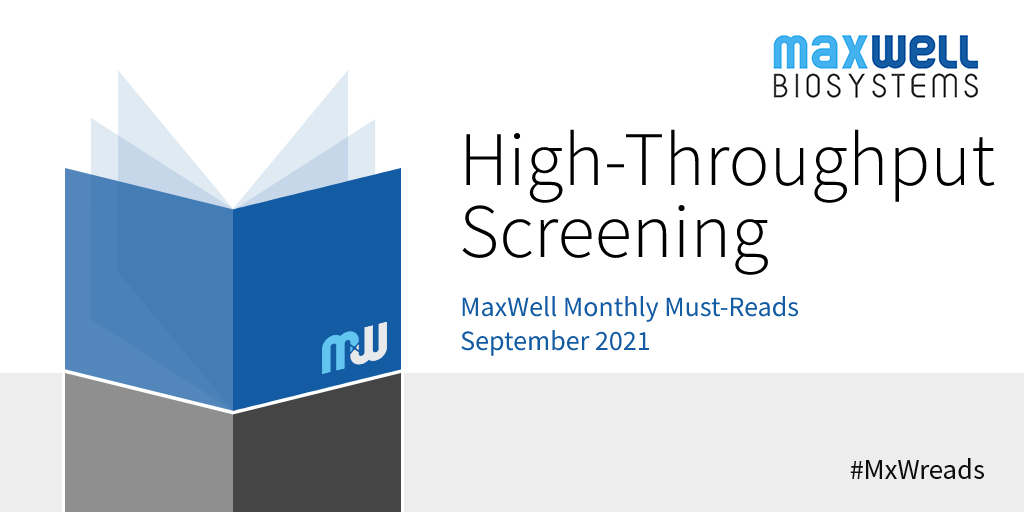

新しいMonthly Must-Readsのお届けです。夏季休暇中の8月号では、最新のCMOSに基づくMEA技術を取り上げました。この9月号では、ハイスループットスクリーニングに焦点を当てることにしました。この記事と共に、次回のウェビナーでは弊社のマルチウェルMEAシステムであるMaxTwoのライブデモを準備しております。ライブデモンストレーションへの登録はこちらで受け付けております。今月号では、人の中脳オルガノイドにおける3Dベース化学的スクリーニングのための完全に自動化したハイスループットワークフローを開発した、Rennerらによって執筆された論文を特集しました。
iPSC Technology for High-Throughput Screenings and Translational Research.
(ハイスループットスクリーニング及びトランスレーショナルリサーチのためのiPS細胞技術)
Renner, H., Grabos, M., Becker, K.J., Kagermeier, T.E., Wu, J., Otto, M., Peischard, S., Zeuschner, D., TsyTsyura, Y., Disse, P., Klingauf, J., Leidel, S.A., Seebohm, G., Schöler, H.R., Bruder, J.M. eLife 9. 2020年11月.
Induced pluripotent stem cell (iPSC) technology enabled the generation of 2D and 3D human samples, which can be used for translational research and high-throughput screenings (HTS). Currently, there is a significant effort in the standardization of techniques for large-scale production of human iPSC-derived neurons and brain organoids, as well as in the development of high-throughput and multiparametric assays for assessing compound effects.
Renner et al. developed a scalable, HTS-compatible workflow for the generation, maintenance, and functional analysis of human organoids in 96-well plate format. The authors demonstrate that human brain organoids can be grown and tested in a fully automated, reproducible and scalable way by RNA sequencing, high-content imaging, and electrophysiological analysis, in order to test of thousands of compounds for e.g. Parkinson’s disease. As reported in the related 4 articles below, human iPSC-derived 2D and 3D samples have also been used for HTS studies including non-neuronal tissue such e.g. retinal epithelium and gastrointestinal organoids.
In conclusion, the combination of iPSC technology for generating human neuronal samples, HTS platforms, multi-parametric assays, and artificial intelligence (AI)-based data analysis aim to revolutionize translation research and drug screenings for brain disease.
Read the paper here.
Although we decided to highlight the article by Renner et al., we selected four scientific articles that delve into the topic of high-throughput:
- High-throughput automated organoid culture via stem-cell aggregation in microcavity arrays.
by Brandenberg, N., Hoehnel, S., Kuttler, F., Homicsko, K., Ceroni, C., Ringel, T., Gjorevski, N., Schwank, G., Coukos, G., Turcatti, G., Lutolf, M.P.. Nature Biomedical Engineering. June 2020.
Read the paper here. - High-throughput screening of human induced pluripotent stem cell-derived brain organoids.
by Durens, M., Nestor, J., Williams, M., Herold, K., Niescier, R.F., Lunden, J.W., Phillips, A.W., Lin, Y.-C., Dykxhoorn, D.M., Nestor, M.W.. Journal of Neuroscience Methods. April 2020.
Read the paper here. - A Human Retinal Pigment Epithelium-Based Screening Platform Reveals Inducers of Photoreceptor Outer Segments Phagocytosis.
by Schreiter, S., Vafia, K., Barsacchi, R., Tsang, S.H., Bickle, M., Ader, M., Karl, M.O., Tanaka, E.M., Almedawar, S. Stem Cell Reports. December 2020.
Read the paper here. - High-throughput Analysis of Synaptic Activity in Electrically Stimulated Neuronal Cultures.
by Van Dyck, M., Mishra, R.K., Pestana, F., Verstraelen, P., Lavreysen, H., Pita-Almenar, J.D., Kashikar, N.D., De Vos, W.H. Neuroinform. August 2021.
Read the paper here.
 日本語
日本語


